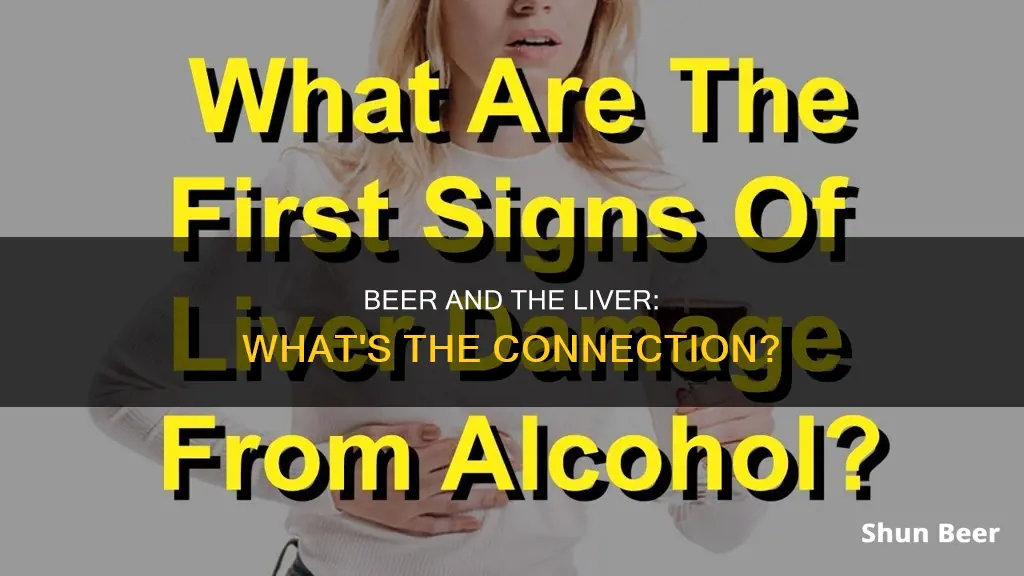
Alcohol is directly toxic to the liver, and so are the byproducts of alcohol metabolism. When the liver metabolizes alcohol, it creates a chemical called acetaldehyde, which is what makes you feel flushed while drinking and contributes to hangovers. This chemical also damages DNA and prevents the body from repairing the damage, which is why at least six cancers are linked to alcohol consumption.
The liver can only process a certain amount of alcohol, and this amount varies from person to person. When you drink more than your liver can process, it can become badly damaged. This initially takes the form of increased fat in the liver, but over time, it can lead to inflammation and the accumulation of scar tissue, resulting in alcoholic liver disease.
| Characteristics | Values |
|---|---|
| Alcohol-related liver disease (ARLD) | Liver damage caused by excess alcohol intake |
| ARLD symptoms | No symptoms until the liver has been severely damaged; yellowing of the eyes or skin (jaundice); swelling in the ankles and tummy; confusion or drowsiness; vomiting blood or passing blood in stools |
| Liver functions | Filtering toxins from the blood; aiding digestion of food; regulating blood sugar and cholesterol levels; helping fight infection and disease |
| Alcoholic fatty liver disease | Build-up of fats in the liver; reversible if you stop drinking alcohol for several months or years |
| Alcoholic hepatitis | A potentially serious condition caused by alcohol misuse over a longer period or binge drinking; mild or severe |
| Cirrhosis | A stage of ARLD where the liver has become significantly scarred; generally not reversible but stopping drinking alcohol can prevent further damage and increase life expectancy |
| Treating ARLD | No specific medical treatment; the main treatment is to stop drinking, preferably for life |
| Preventing ARLD | Stop drinking alcohol or stick to recommended limits: men and women advised not to regularly drink more than 14 units a week; one unit equals half a pint of normal-strength lager |
| Fatty liver disease | A build-up of fat in the liver; can lead to inflammation and an increased risk of cirrhosis, liver disease, and liver cancer |
| Alcohol-associated hepatitis | Acute inflammation of the liver; death of liver cells, followed by permanent scarring |
| Alcohol-associated cirrhosis | Destruction of normal liver tissue; scar tissue replaces working liver tissue, impairing liver function |
| Alcohol-associated liver disease symptoms | Build-up of fat inside liver cells causing upper belly discomfort on the right side; tiredness and weakness; abdominal discomfort or pain; yellowing of the skin and eyes (jaundice); bleeding in the gastrointestinal tract; fluid build-up in the belly (ascites); increased infections |
| Alcohol-associated liver disease treatment | Stop consuming alcohol; participate in an alcohol use disorder treatment program; dietary changes; time for the liver to recover |
What You'll Learn

Alcoholic fatty liver disease
The liver is responsible for breaking down alcohol, but when you drink more than your liver can process, it can become damaged. The process of breaking down alcohol generates harmful substances that can damage liver cells, promote inflammation, and weaken your body's natural defences. The more alcohol you consume, the more damage you inflict on your liver.
The good news is that alcoholic fatty liver disease is reversible. Abstaining from alcohol for an extended period, ranging from several weeks to months or even years, can allow the liver to recover and return to normal. For some individuals, permanent abstinence may be necessary.
If you are concerned about your alcohol consumption or suspect you may have alcoholic fatty liver disease, it is important to consult a healthcare professional. They can provide guidance, support, and a treatment plan to help manage the condition and any associated withdrawal symptoms.
Revy's Beer Choice: What's Her Favorite Brew?
You may want to see also

Alcoholic hepatitis
The symptoms of alcoholic hepatitis include abdominal discomfort or pain, yellowing of the skin and eyes (jaundice), reduced blood flow through the liver (portal hypertension), bleeding in the gastrointestinal tract, fluid build-up in the belly (ascites), and increased infections.
The diagnosis of alcoholic hepatitis is typically clinical, based on symptoms and supporting laboratory findings. Abdominal imaging studies, such as ultrasounds, CT scans, and MRIs, may be used to exclude other liver diseases or biliary tract disorders. A liver biopsy is generally not required unless there is uncertainty about the cause of the hepatic injury.
The treatment for alcoholic hepatitis focuses on abstinence from alcohol, adequate nutritional support, and, in some cases, pharmacological interventions. Abstaining from alcohol is crucial for managing alcoholic hepatitis and preventing further liver damage. Mild alcoholic hepatitis can be completely reversed with the cessation of alcohol consumption. However, for those who continue drinking, alcoholic hepatitis usually progresses to cirrhosis, a stage of liver disease characterised by significant scarring.
In severe cases of alcoholic hepatitis, a liver transplant may be necessary if the patient does not respond to other treatments. However, there are barriers to liver transplantation for patients with alcoholic hepatitis, including fear of recidivism, organ shortage, and social and ethical considerations.
Alcohol-Free Beer and Gout: Is It Safe to Drink?
You may want to see also

Cirrhosis
The symptoms of cirrhosis are similar to those of alcoholic hepatitis and include jaundice (yellowing of the skin and eyes), loss of appetite and weight loss, and swelling in the ankles and abdomen. However, even at this stage, there may not be any obvious symptoms.
- Portal hypertension: a narrowing or blockage of the vein that brings blood to the liver, increasing blood pressure and contributing to bleeding in the digestive tract.
- Ascites: the accumulation of fluid in the abdomen, which can be associated with kidney failure.
- Hepatic encephalopathy: impaired brain function due to the damaged liver's reduced ability to remove toxic waste products from the blood, leading to drowsiness and confusion.
- Increased risk of infection: cirrhosis can cause an enlarged spleen, which traps and destroys more white blood cells, reducing the body's ability to fight infections.
- Bleeding in the digestive tract: portal hypertension can cause veins in the oesophagus and stomach to enlarge and bleed.
- Liver failure: as the liver loses its function, it can eventually lead to kidney failure and death.
The best treatment for cirrhosis is to stop drinking alcohol immediately, as this can prevent further damage and significantly improve life expectancy. However, cirrhosis is generally not reversible, and severe cases may require a liver transplant.
Alcoholics and Beer: One Sip Too Many?
You may want to see also

Alcohol-induced liver cancer
Alcohol consumption is a leading cause of liver damage. When liver damage occurs due to alcohol, it is called alcohol-related liver disease (ARLD). ARLD can progress through three main stages: alcoholic fatty liver disease, alcoholic hepatitis, and alcoholic cirrhosis. Alcoholic fatty liver disease is the most common form of ARLD, affecting up to 90% of heavy drinkers. It is characterised by a build-up of fat in the liver, which can inhibit the breakdown of fats and lead to inflammation and the accumulation of scar tissue. This can impair the liver's ability to function properly.
Alcohol consumption is also associated with an increased risk of developing several types of cancer, including liver cancer. Heavy alcohol consumption is linked to a twofold increased risk of developing hepatocellular carcinoma and intrahepatic cholangiocarcinoma. The risk of developing these types of liver cancer is higher in individuals who consume larger amounts of alcohol over a long period. Additionally, women may be more susceptible to alcohol-induced liver damage and have a higher risk of developing liver cancer compared to men when consuming similar amounts of alcohol.
The mechanisms underlying alcohol-induced liver cancer are not yet fully understood, but several factors have been proposed. One factor is the mutagenic effects of acetaldehyde, a toxic byproduct of alcohol metabolism. Acetaldehyde can damage DNA and proteins, increasing the risk of cancer. Another factor is the production of reactive oxygen species (ROS) during alcohol metabolism, which can cause oxidative stress and damage to DNA, proteins, and lipids in the body.
Furthermore, alcohol consumption can increase the risk of liver cancer in individuals with certain risk factors, such as hepatitis virus infection, diabetes, and obesity. The combination of alcohol consumption and these risk factors can further elevate the chances of developing liver cancer.
It is important to note that even moderate alcohol consumption can increase the risk of liver cancer, and the optimal number of drinks to minimise overall health risks is zero. Abstaining from alcohol or drinking in moderation can help lower the risk of liver cancer and improve liver health.
Beer and Workouts: Friends or Foes?
You may want to see also

Alcoholic hepatitis treatment
Alcoholic hepatitis is a potentially serious condition caused by alcohol misuse over a long period. It can also occur if a person binge drinks a large amount of alcohol in a short period.
The treatment for alcoholic hepatitis depends on the severity of the condition. In mild cases, no specific treatment is required, and the short-term prognosis is good. Hospitalization is not always necessary, but alcohol use must be stopped, and good nutrition maintained.
For severe acute alcoholic hepatitis, hospitalization in an intensive care unit (ICU) is often required until liver function stabilizes and the patient begins to improve. Specific therapies may be directed towards reducing liver injury, enhancing hepatic regeneration, and suppressing inflammation. Glucocorticosteroids are widely used for this purpose, although their benefits have not been proven.
Liver transplantation may be required in severe cases where the liver has stopped functioning and does not improve when a person stops drinking alcohol. However, most patients with active alcoholic hepatitis are excluded from transplantation due to ongoing alcohol abuse. In the United States, patients must typically abstain from alcohol for at least 6 months before being considered for a transplant.
The only demonstrated benefit for all areas of alcoholic hepatitis treatment—improvement of liver function, prevention of progression to cirrhosis, and reduction of mortality—is prolonged alcohol abstinence.
Keto and Diet Root Beer: Is It Allowed?
You may want to see also
Frequently asked questions
The liver is a large organ that sits under the ribs on the right side of the body. It has many functions, including filtering toxins from the blood, producing bile to aid digestion, regulating blood sugar and cholesterol levels, and helping fight infection and disease.
Drinking beer, like any other form of alcohol, can cause a build-up of fat in the liver, known as alcoholic fatty liver disease. This can lead to inflammation and an increase in scar tissue, impairing the liver's ability to function properly.
In the early stages, liver damage from alcohol may not cause any noticeable symptoms. As the condition progresses, symptoms may include pain or discomfort in the upper right side of the abdomen, fatigue, jaundice (yellowing of the skin and eyes), swelling in the ankles and tummy, confusion or drowsiness, and vomiting blood or passing blood in stools.
Excessive alcohol consumption is generally defined as more than 14 units of alcohol per week for both men and women. A unit of alcohol is equal to about half a pint of normal-strength lager or a pub measure (25ml) of spirits.
To protect your liver, it is recommended to drink in moderation or abstain from alcohol altogether. Maintaining a healthy weight, eating a balanced diet, and exercising regularly can also help improve liver health.







